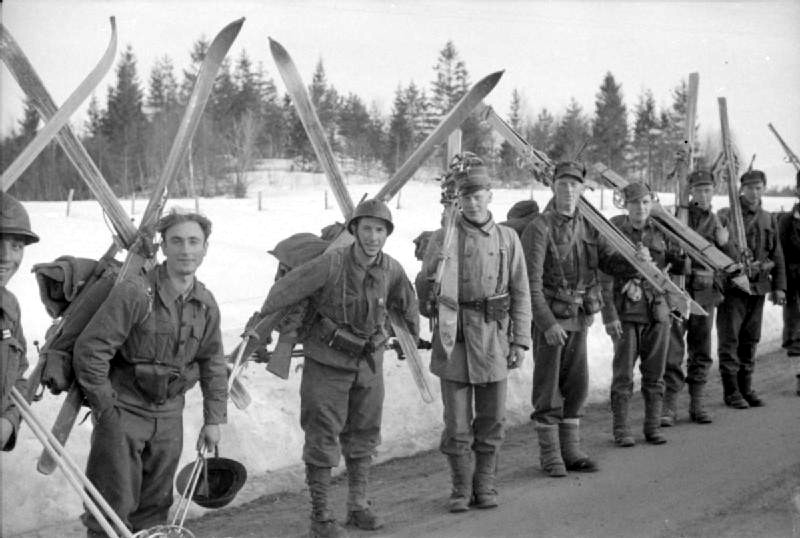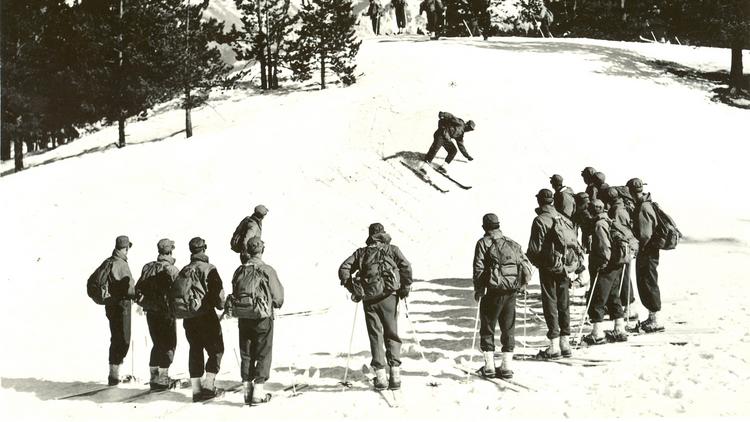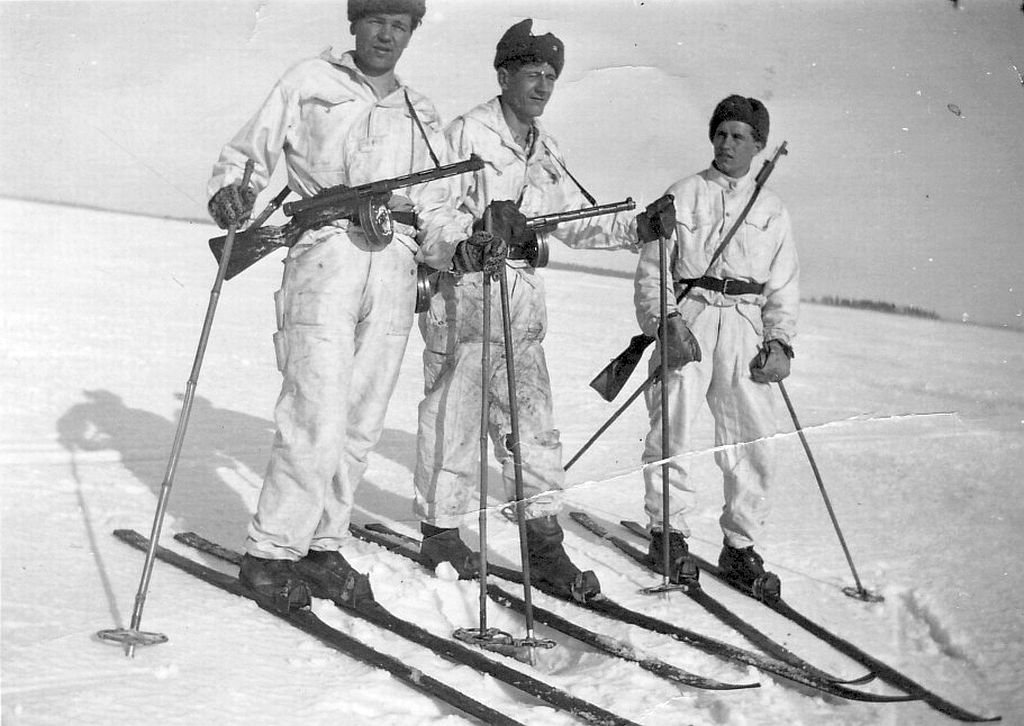Napoleonic Wars
Denmark-Norway (though only Norwegian) ski troops were used against Sweden during the 1807–1814 Napoleonic Wars.
-------------------------------------------------------------------------------
a break in the forest
Full explosive sleigh pushed forward and men preparing and make ready many traps to Russian troops
--------------------------------------------------------------------------
Skis
Asymmetrical skis were used at least in northern Finland and Sweden up until the 1930s. On one leg the skier wore a long straight non-arching ski for sliding, and on the other a shorter ski for kicking. The bottom of the short ski was either plain or covered with animal skin to aid this use, while the long ski supporting the weight of the skier was treated with animal fat in similar manner to modern ski waxing . Early record of this type of skis survives in works of Olaus Magnus. He associates them to Sami people and gives Sami names of savek and golos for the plain and skinned short ski. Finnish names for these are lyly and kalhu for long and short ski.
The seal hunters at the Gulf of Bothnia had developed a special long ski to sneak into shooting distance to the seals' breathing holes, though the ski was useful in moving in the packed ice in general and was made specially long, 3 - 4 meters, to protect against cracks in the ice. This is called skredstång in Swedish.
Around 1850 artisans in Telemark, Norway invent the cambered ski. This ski arches up in the middle, under the binding, which distributes the skier's weight more evenly across the length of the ski. Earlier plank-style skis had to be thick enough not to bow downward and sink in the snow under the skier's weight. Norheim's ski was also the first with a sidecut that narrowed the ski underfoot while the tip and tail remained wider. This enabled the ski to flex and turn more easily.
In 1950 Howard Head introduced the Head Standard, constructed by sandwiching aluminum alloy around a plywood core. The design included steel edges (invented in 1928 in Austria) and the exterior surfaces were made of phenol formaldehyde resin which could hold wax. This hugely successful ski was unique at the time in having been designed for the recreational market, rather than for racing. 1962: a fibreglass ski, Kneissl 's White Star, was used by Karl Schranz to win two gold medals at the FIS Alpine World Ski Championships. By the late '60s fibreglass had mostly replaced aluminum.
In 1975 the torsion box ski construction design is patented. The patent is referenced by Kästle, Salomon, Rottefella , and Madshus, but in fact torsion box skis became common beginning in 1962 with the introduction of the Dynamic VR7 and VR17 race skis. In 1993 Elan introduced the Elan SCX. These introduced a new ski geometry, common today, with a much wider tip and tail than waist. When tipped onto their edges, they bend into a curved shape and carve a turn. Other companies quickly followed suit, and it was realized in retrospect that "It turns out that everything we thought we knew for forty years was wrong." The modern Twin-tip ski was introduced by Line in 1995.
-----------------------------------------------------------------------------
World War I
During WWI the Italian Army raised 88 Alpini Battalions. Their purpose was to fight summer and winter in the highest regions of the Alpine Arch. Most of the battalions were dissolved after WWI.
Only nine Alpini regiments remain in service today, and only four still train every soldier in ski warfare: the 4th Alpini Parachutist Regiment , 5th Alpini Regiment , 6th Alpini Regiment and 7th Alpini Regiment.

British troops in Norway, April 1940

Canadian ski patrol, 1944

U.S. Army 10th Mountain Division ski troops trained at Camp Hale near Leadville in the 1940s
U.S. Army ski troops colorado
World War II
See also: GebirgsjägerSki troops played a key role in the successes of the Finnish war effort against the Soviet Union during the Winter War in 1939. Forested, rural terrain with no roads was used by Finnish ski troops with great success against the advancing mechanized Soviet troops. In the Battle of Suomussalmi, two Soviet mechanized divisions (45,000 men) were annihilated by three Finnish regiments (11,000 men).
The Soviet Union deployed 11 ski battalions , among other troops, in November 1941 to reinforce their defenses in the Battle of Moscow.
The most common transportation for Norwegian soldiers during the Norwegian Campaign in 1940 was skis and sleds, and in Operation Gunnerside , paradropped Norwegian commandos covered a large distance using skis in order to reach and sabotage the heavy water plant Vemork at Rjukan in Telemark, Norway , which was being used by the Germans as part of their nuclear research programme.
Ski warfare even extended to the Middle East where the Australian Ski Corps were deployed against Vichy French forces in the mountains of Lebanon.
Also during WWII, the United States Army 10th Mountain Division was established and trained for ski combat. They were deployed in Italy.

Soviet... (winter war)
Swedish...

Norwegian...

Finnish..
A detachment of German Gebirgsjäger on skis. Gebirgsjäger, alpine shooters (Alpini) - specialized formations of the ground forces (Wehrmacht), prepared for...

Russian ski patrol

Japan ski patrol
Estonian troops
Swedish, Finnish and Norwegian defense forces use skis in cross country skiing but also by pulling squads of soldiers with tracked transport vehicles or snow mobiles. One or two ropes hang from the end of a tracked vehicle such as the famous Swedish Hägglunds Bandvagn 206 or the Finnish Sisu Nasu and troops hang onto the ropes with their hands and ski-poles.
Reindeer waiting for departure. Petsamo, Kukkesjaur 1942.04.12
Many nations train troops in skiing and winter warfare, including:
Austrian Army
- Certain soldiers are trained in ski combat.
Danish Navy
- Slædepatruljen Sirius (Sirius Arctic Patrol) patrols Northern and Eastern Greenland.
Estonian Army
- Conscripts routinely receive training in skiing and other winter warfare skills.
Finnish Army
- All soldiers are trained in ski combat, and skiing is a part of standard required training for conscripts.
French Army -
27th Chasseurs Alpins Brigade
German Bundeswehr
- Gebirgsjäger
Hellenic Army
- Greek Special Forces Command has a mountain ski warfare training center
(ΚΕΟΑΧ ) on Mount Olympus for Marines and Commandos.
Italian Army
- the Alpini Corp with 16 Regiments.
Lebanese Armed Forces
- Mountain Combat Company part of the Lebanese Commando Regiment
Netherlands
- Royal Netherlands Marine Corps, Korps Commandotroepen and the 11 Luchtmobiele Brigade - annual exercises taking place in the interior of Northern Norway
Norwegian Army
- All soldiers are trained in ski combat.
Polish Army
- 21st Podhale Rifles Brigade and elements of the 6th Paratroopers Brigade.
Romanian Land Forces
- Vânători de Munte (Mountain Hunters), all soldiers are trained in ski combat.
Spain
- "Brigada de Cazadores de Montaña Aragón I" (Mountain Light Infantry Brigade Aragón I), in Jaca (Huesca) with a specialized section "Compañía de Esquiadores-Escaladores" (Skiing-Climbing Company), in Jaca (Huesca).
Slovenian army
- 132nd Mountain Battalion is trained in ski combat and mountain survival, Slovenian army is member of International Federation of Mountain Soldiers - IFMS. Slovenia is also a host nation for NATO's Multinational Centre of Excellence for Mountain Warfare.
Sweden
- Majority of soldiers are trained in ski combat
Switzerland's
- 3rd Mountain Army Corps (Corps d'armée de montagne 3)
United Kingdom
- Members of the Royal Marines 3 Commando Brigade are trained in alpine and cold weather warfare at facilities in Norway.
United States
- The United States Marine Corps through the Marine Corps Mountain Warfare Training Center in northern California; the US Army in Alaska at the Northern Warfare Training Center and the Army Mountain Warfare School in Jericho, Vermont and the US Navy also in Alaska at Naval Special Warfare Cold Weather Detachment Kodiak.
----
Other information
The Norwegian military have held skiing competitions since the 1670s. The sport of biathlon was developed from military skiing patrols.
----
The United States ski patrol plays a vital role in the plot to the book A Separate Peace
----
Australia's first ski troops by Col. RW Savage in Australian Ski Yearbook, 1942. Reprinted in: Bill Beatty. The white roof of Australia . Cassell, 1958. pp. 77-80.
External links
Finnish Tracked transport vehicle, SISU NA 110
Ei kommentteja:
Lähetä kommentti
Any explosive ammunition or empty cores, you can put in this.